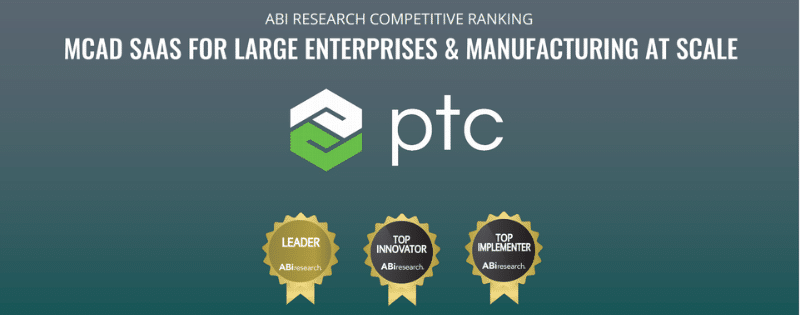Finding the right 3D modeling solution for your organization is critical to running your business. The right solution will have the tools your team needs to create new and innovative products help increase productivity, and streamline the entire design process.
The right CAD solution provides the tools your team needs, increases productivity, and streamline the design process.
If you are in the market for a new CAD solution or are looking to switch solutions you are probably considering the top players: Creo, CATIA, Inventor, Pro/E, or SolidWorks. While every solution has its pros and cons we are focusing this CAD comparison and feature breakdown on Creo vs CATIA.
Full disclosure – as a PTC reseller we are slightly biased in our preference toward Creo. However, our expertise in this market provides us with some additional insight into what features are most valuable to customers and we have made every effort to be as unbiased as possible in this article.
CAD Comparison: Feature Breakdown
Ease of Use: Creo Wins
How your engineering team operates on a day-to-day basis will have a huge impact on your overall business. If your team is inefficient then you could be losing money. Ease of use is a critical component to consider when investing in a CAD solution.
Creo was designed for the cloud. Over its many versioning iterations, the UI has been streamlined and modernized with engineers in mind to increase day-to-day productivity. Creo includes built-in tutorials and training tools to ensure that engineers can quickly learn and understand how to use every feature. Plus, integrated eLearning provides even more training and education for everything and is built right into the platform.
CATIA’s UI has also undergone recent modernization but still feels stuck in its client-server-era setup. Some engineers find it easy to use for basic CAD requirements and functionality but then struggle to find what they need for more advanced functionality.
Creo’s modernized UI streamlines productivity – making it the winner in this category.
3D CAD Modeling: Creo and CATIA Tie

Obviously, when selecting a CAD solution, 3D modeling capabilities are also one of the most important features to look for. If a solution doesn’t have the tools you need, you could be forced to supplement with other platforms and incur additional costs.
Both Creo and CATIA have complete functionality when it comes to 3D CAD modeling. You are likely to find the required capabilities you need in either solution. Each solution has some features that the other does not, but either way, both are highly functional. Given the robust capabilities of both platforms, we are calling this one a draw.
Industry 4.0, Digital Transformation, IoT, and AR: Creo Wins
PTC has been quick to add tools and features that support the future of design and manufacturing operations from industry 4.0, to the digital transformation, and all other supporting technologies. Companies looking to undergo a complete digital transformation will find the capabilities they need within the PTC Creo CAD package.
In contrast, although CATIA focuses on industries such as oil, gas, and energy – all of which began their digital transformation processes early on – CATIA seems to have missed the mark on quickly adapting and adding these features to their platform.
Creo continues to keep its platform up to date to support the latest technological trends.
Industries Supported: Creo and CATIA Tie
CATIA supports a huge range of industries including:
- Manufacturing
- Financial services
- Aerospace
- Natural resources
CATIA claims to support a total of 12 main industries, which have then been broken down into 52 subsegments each with its own challenges and solutions. At first glance, this may look like an advantage, as the number of industries appears more substantial, but specialization of this nature is hard for any company to sustain. It is likely that Dassault has, at best, simply a surface understanding for each of the sub-segmented industries and their challenges.
Creo maintains its focus on just six industries and provides comprehensive information about the use of its products and services for each industry. This critical focus demonstrates PTC’s clear understanding of specific industry challenges and the solutions their platform can provide. If your specific industry is not among PTC’s focus, then CATIA may be the better option.

Integration and Compatibility: Creo Wins
CATIA maintains a few partnerships and Dassault has a range of additional engineering tools in their catalog but overall their integration into other systems is lacking. CATIA plays well with other Dassault tools but sharing files with outside systems is clunky at best.
Similarly, Creo integrates seamlessly with other PTC tools but also includes Unite Technology, a built-in integration and file sharing solution. This makes it easy to work with other teams that may be using a different CAD tech stacks by allowing users to open files created in these other systems by simply clicking on them with no additional file conversion. This simplified collaboration tool makes Creo the winner in this category.
Unite Technology allows Creo users to easily collaborate with other CAD systems.
Deployment Flexibility: Creo Wins
PTC has heavily focused on its cloud offerings since the beginning – even before cloud deployment was a common solution. This early adoption provides them with many referenceable cloud customers of all sizes across all six of their focus industries. Plus, PTC’s annualized subscription license model revenue for 2018 is up 61% YOY from 2017.

In contrast, Dassault doesn’t break out recurring license revenue by individual product line but total recurring revenue for the company is 26% – with little change from 2017. Their cloud references are fairly limited to smaller organizations likely attracted to this deployment option due to its perceived lower costs.
These numbers imply that Dassault has not made huge progress in their cloud offerings. It is common for most software companies to experience an initial dip in revenue as they convert to cloud deployments and Dassault still must cross this path. Unfortunately, being this late to the cloud party could make it particularly difficult to make up for lost time.
Who is the winner in the Creo vs CATIA CAD software comparison? PTC Creo
As we mentioned earlier, we are biased towards Creo but our experience with a range of 3D CAD tools in the market and customer insights have given us a clear picture of what features organizations find most important. We understand what capabilities are critical in the day-to-day operations of an organization and what truly helps increase productivity. Given that, we are confident in saying that while CATIA is a strong CAD solution, PTC Creo is the superior choice.
If you would like to learn more about Creo or have specific questions about platform features, contact us.
Or if you would like to know how it stacks up against some of the other industry leading CAD systems, check out our other comparisons:
- CAD Battle: PTC Creo vs. Autodesk Inventor
- CAD Comparison: Creo vs Pro/E
- Debunking 3 Myths about PTC Creo and SolidWorks

